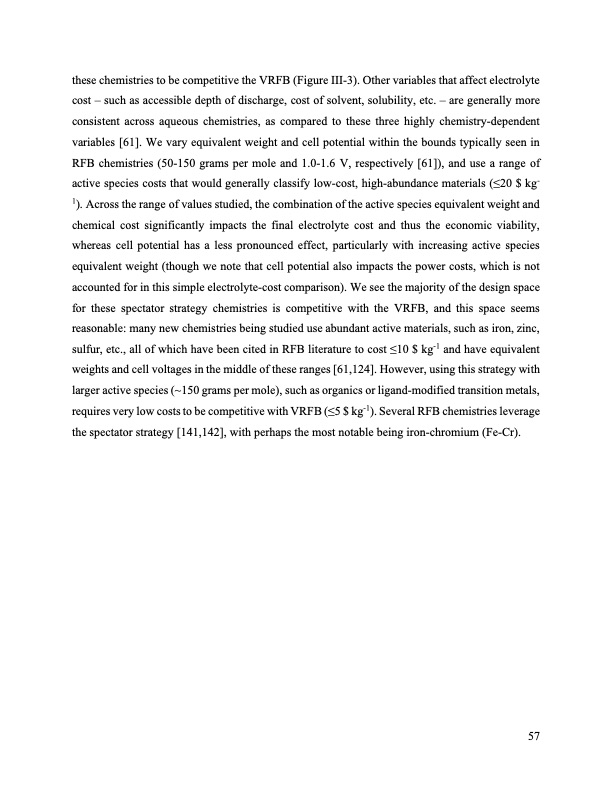
PDF Publication Title:
Text from PDF Page: 057
these chemistries to be competitive the VRFB (Figure III-3). Other variables that affect electrolyte cost – such as accessible depth of discharge, cost of solvent, solubility, etc. – are generally more consistent across aqueous chemistries, as compared to these three highly chemistry-dependent variables [61]. We vary equivalent weight and cell potential within the bounds typically seen in RFB chemistries (50-150 grams per mole and 1.0-1.6 V, respectively [61]), and use a range of active species costs that would generally classify low-cost, high-abundance materials (≤20 $ kg- 1). Across the range of values studied, the combination of the active species equivalent weight and chemical cost significantly impacts the final electrolyte cost and thus the economic viability, whereas cell potential has a less pronounced effect, particularly with increasing active species equivalent weight (though we note that cell potential also impacts the power costs, which is not accounted for in this simple electrolyte-cost comparison). We see the majority of the design space for these spectator strategy chemistries is competitive with the VRFB, and this space seems reasonable: many new chemistries being studied use abundant active materials, such as iron, zinc, sulfur, etc., all of which have been cited in RFB literature to cost ≤10 $ kg-1 and have equivalent weights and cell voltages in the middle of these ranges [61,124]. However, using this strategy with larger active species (~150 grams per mole), such as organics or ligand-modified transition metals, requires very low costs to be competitive with VRFB (≤5 $ kg-1). Several RFB chemistries leverage the spectator strategy [141,142], with perhaps the most notable being iron-chromium (Fe-Cr). 57PDF Image | Bringing Redox Flow Batteries to the Grid

PDF Search Title:
Bringing Redox Flow Batteries to the GridOriginal File Name Searched:
Rodby-krodby-phd-chemE-2022-thesis.pdfDIY PDF Search: Google It | Yahoo | Bing
Salgenx Redox Flow Battery Technology: Salt water flow battery technology with low cost and great energy density that can be used for power storage and thermal storage. Let us de-risk your production using our license. Our aqueous flow battery is less cost than Tesla Megapack and available faster. Redox flow battery. No membrane needed like with Vanadium, or Bromine. Salgenx flow battery
| CONTACT TEL: 608-238-6001 Email: greg@salgenx.com | RSS | AMP |